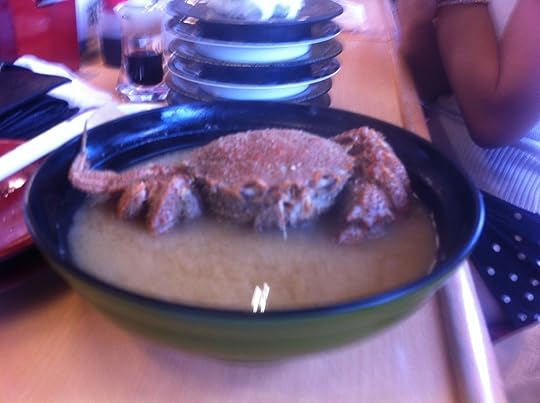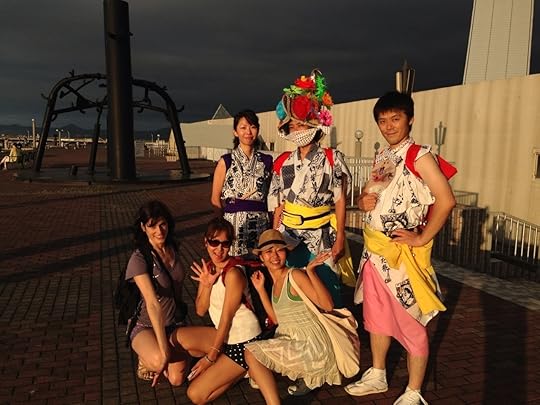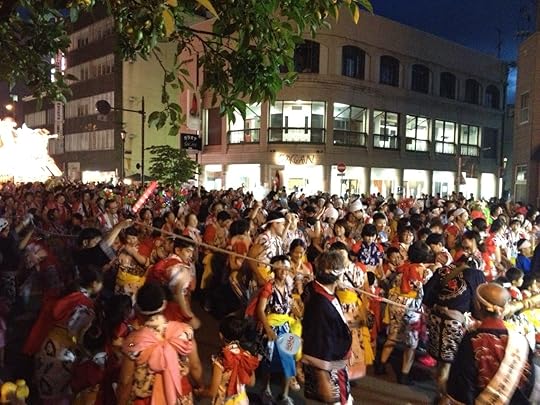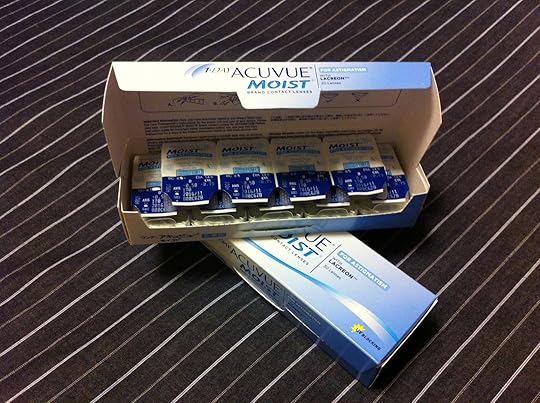Sandra Thompson's Blog, page 4
August 9, 2013
There's no escaping Tokyo
Sometimes I really feel the need to get away from the crowds of Tokyo and escape to the peaceful Japanese countryside. Last weekend I went to the rural apple-growing prefecture of Aomori (715km north of Tokyo) to watch the Nebuta festival with some friends.
Aomori is on the coast, so the first thing we did when we arrived was to look for local sushi. We wanted to eat the best, freshest fish - straight from the sea, and into our mouths. We found a great sushi bar where the fish were as delicious and fresh as anything we’d eaten in Tokyo, and a bargain at country prices!
 Surprise! A crab was hiding in the miso soup.
Surprise! A crab was hiding in the miso soup.
When we arrived at the festival that evening, there were hundreds of performers dressed in traditional costumes getting ready for the Nebuta parade. We were excited to see them and stopped a few Aomori locals to get a picture with them before the show. But as it turned out they weren’t from Aomori at all. Like us they’d travelled from far away to spend the weekend in the country.
 Aomori imposters with other Aomori imposters
Aomori imposters with other Aomori imposters
Finally we went to get a seat at the parade. I thought we wouldn’t have too much trouble with crowds because it was a small town but it was packed out like Shinjuku station at peak hour. Tokyo had found me after all. The event had drawn the masses from the capital. Luckily I’ve learnt a few things about walking through crowds, so I had no problem and the crowds added to the excitement.
 Tokyo relocates to Aomori
Tokyo relocates to Aomori
The parade was amazing - huge floats made of Japanese paper and carried by man-power, surrounded by dancers and musicians in traditional costumes. We discovered that if we cheered loud enough the floats would walk over to us and bow.
Even the floats bow in Japan
I highly recommend the festival in Aomori as a great thing to see. But book early because the rest of Tokyo will be there with you!
Aomori is on the coast, so the first thing we did when we arrived was to look for local sushi. We wanted to eat the best, freshest fish - straight from the sea, and into our mouths. We found a great sushi bar where the fish were as delicious and fresh as anything we’d eaten in Tokyo, and a bargain at country prices!
 Surprise! A crab was hiding in the miso soup.
Surprise! A crab was hiding in the miso soup. When we arrived at the festival that evening, there were hundreds of performers dressed in traditional costumes getting ready for the Nebuta parade. We were excited to see them and stopped a few Aomori locals to get a picture with them before the show. But as it turned out they weren’t from Aomori at all. Like us they’d travelled from far away to spend the weekend in the country.
 Aomori imposters with other Aomori imposters
Aomori imposters with other Aomori impostersFinally we went to get a seat at the parade. I thought we wouldn’t have too much trouble with crowds because it was a small town but it was packed out like Shinjuku station at peak hour. Tokyo had found me after all. The event had drawn the masses from the capital. Luckily I’ve learnt a few things about walking through crowds, so I had no problem and the crowds added to the excitement.
 Tokyo relocates to Aomori
Tokyo relocates to AomoriThe parade was amazing - huge floats made of Japanese paper and carried by man-power, surrounded by dancers and musicians in traditional costumes. We discovered that if we cheered loud enough the floats would walk over to us and bow.
Even the floats bow in Japan
I highly recommend the festival in Aomori as a great thing to see. But book early because the rest of Tokyo will be there with you!
Published on August 09, 2013 04:29
June 23, 2013
What happens when you get cocky
You would think after my disastrous Japanese interview in April I should have no doubts about my terrible Japanese skills. But recently I still made the mistake of thinking I could communicate like a normal person.
I wanted a new contact lens prescription but instead of trying to find an English speaking optometrist, I decided to go to a local and wing it. On the surface, that doesn’t sound difficult. But don’t forget I have the reading skills of a five year old, and the speaking skills of a baby. I had to decipher websites and maps, make an appointment, and then once I’d finally arrived, fill out the pre-appointment health sheet – all in Japanese.
Somehow I managed it. (I won’t mention how long it took and how many mistakes I made.) As I sat in the waiting room for my appointment I felt so pleased with myself. I fantasised about how I was going to email everyone I knew and boast about my cleverness.
Then the eye exam began... The optometrist made me put my head in a contraption and stare at a computer screen. She said, “Blah blah blah blah?”
At least that’s what it sounded like. I could see a white C shape but it wasn’t perfectly clear around the edges so I replied, “Can’t see.” The optometrist nodded and made the C shape bigger, then said, “Blah blah blah blah?”
I repeated “Can’t see.”
The C got bigger and bigger and bigger. She repeated her question again and again and again. I answered “Can’t see,” “Can’t see,” “Can’t see.”
Finally the C was so big that it didn’t fit on the computer screen anymore. There was no way anyone could miss it. The optometrist seemed frustrated by now. She opened a cupboard and pulled out a giant poster of a C. She held the poster close to my face and said “Blah blah blah blah?” I replied, “Can’t see.” The optometrist’s nostrils flared. I started to suspect that I’d misunderstood the question.
We moved on to other tests. I tried on glasses, put my head in different machines, and looked at charts on the wall. This time she changed her question. She kept saying “Blah blah blah… Is that okay?” I didn’t want to cause any more trouble so I answered “Is okay, is okay, is okay,” and she kept looking more and more angry.
By the end of the appointment, my spirits had plummeted. I’d wasted everyone’s time and my money. I couldn’t believe I’d gotten so cocky as to think I could take an eye exam in Japanese. Then I got my prescription… it was exactly the same as my old one!
 My new contact lenses - not even the optometrist knows if they're right for me.
My new contact lenses - not even the optometrist knows if they're right for me.
I don’t know if my eyesight really hasn’t changed, or if the optometrist just gave up on me and copied out my old prescription. But I have new contact lenses now and they seem to be okay. So I’m choosing to believe that I got what I wanted. I’m back to being cocky.
I wanted a new contact lens prescription but instead of trying to find an English speaking optometrist, I decided to go to a local and wing it. On the surface, that doesn’t sound difficult. But don’t forget I have the reading skills of a five year old, and the speaking skills of a baby. I had to decipher websites and maps, make an appointment, and then once I’d finally arrived, fill out the pre-appointment health sheet – all in Japanese.
Somehow I managed it. (I won’t mention how long it took and how many mistakes I made.) As I sat in the waiting room for my appointment I felt so pleased with myself. I fantasised about how I was going to email everyone I knew and boast about my cleverness.
Then the eye exam began... The optometrist made me put my head in a contraption and stare at a computer screen. She said, “Blah blah blah blah?”
At least that’s what it sounded like. I could see a white C shape but it wasn’t perfectly clear around the edges so I replied, “Can’t see.” The optometrist nodded and made the C shape bigger, then said, “Blah blah blah blah?”
I repeated “Can’t see.”
The C got bigger and bigger and bigger. She repeated her question again and again and again. I answered “Can’t see,” “Can’t see,” “Can’t see.”
Finally the C was so big that it didn’t fit on the computer screen anymore. There was no way anyone could miss it. The optometrist seemed frustrated by now. She opened a cupboard and pulled out a giant poster of a C. She held the poster close to my face and said “Blah blah blah blah?” I replied, “Can’t see.” The optometrist’s nostrils flared. I started to suspect that I’d misunderstood the question.
We moved on to other tests. I tried on glasses, put my head in different machines, and looked at charts on the wall. This time she changed her question. She kept saying “Blah blah blah… Is that okay?” I didn’t want to cause any more trouble so I answered “Is okay, is okay, is okay,” and she kept looking more and more angry.
By the end of the appointment, my spirits had plummeted. I’d wasted everyone’s time and my money. I couldn’t believe I’d gotten so cocky as to think I could take an eye exam in Japanese. Then I got my prescription… it was exactly the same as my old one!
 My new contact lenses - not even the optometrist knows if they're right for me.
My new contact lenses - not even the optometrist knows if they're right for me.I don’t know if my eyesight really hasn’t changed, or if the optometrist just gave up on me and copied out my old prescription. But I have new contact lenses now and they seem to be okay. So I’m choosing to believe that I got what I wanted. I’m back to being cocky.
Published on June 23, 2013 05:14
June 16, 2013
Making an ebook cover is like a reality TV show
My first novel,
The Ghostly Grammar Boy
, will be published in September so recently I've been working on getting an ebook cover made. I used the graphic design website 99 Designs and the process felt like a reality TV show. This is how I did it.
1. Make the design brief a competition
The Ghostly Grammar Boy is a teen thriller about Fiona, a fifteen year old Canberra school girl who can see and talk to ghosts, including her dead twin sister. Fiona just wants to survive year ten without revealing herself to be a ghost-whispering, boyfriend-less weirdo. Her plans are ruined when she meets the ghost of a handsome boy from the Grammar School who claims he was murdered.
My design brief was to create a cover that had a teenage girl with dark brown hair in the forefront, the title in large font, and my name in capital letters. In the background I wanted a ghost version of the girl (the twin), and the ghost of a handsome teenage boy. I asked for some sparkles or swirls to indicate supernatural themes, for the main colour scheme to be dark purple and black, and for the design to be attractive to teenage girls.
I advertised the brief on 99 Designs and turned it into a competition. Graphic designers were able to compete to win a cash prize.
2. The contestants fight amongst themselves
Within hours of my design brief going up on the website, I already had several great entries... and the fighting had begun. One contestant put up a cover with a picture of a teenage girl taken from a stock photo website. Another contestant entered a similar design using exactly the same picture. The original contestant then complained "There are plenty of pictures on stock sites and you choose to use the same I did!"
3. The contestants fight with the judge
Within a few days I had more than 60 great covers from different designers. I'd originally envisioned a cartoonish cover but most of the designers chose to go with photographs. It was great to be able to see all the different possibilities and interpretations of my brief.
Using the website I could rate each of the covers and give feedback. The designers were responsive to my comments and within a short time submitted new designs including my suggestions. I gave the designers a link to the first three chapters of the book so they could get a sense of the tone of the novel.
One of the designers didn't take my feedback very well and wrote critical comments about how I was confused about the concept of manga, and how I shouldn't have released information late in the competition (for example, during the finals I told the designers "the book is humorous and the girl is spunky - think Buffy not Twilight"). I felt like the mean judge in a reality TV show. The competition was getting fierce.
4. The general public votes
Four days after advertising my design brief I had to narrow down the 23 contestants to six finalists. Using the website I made a poll of my favourite covers and advertised the poll on Facebook, Twitter, and Google Plus. I received many votes from friends, family, and the general public. Thank you to everyone who voted! The comments were very interesting, from "stalkerish," "the girl is too cool," to "looks like a movie starring Sandra Thompson, [2 stars]."
From the polls, a clear favourite emerged, confirming my own feelings about the designs.
5. Pick a winner
Seven days later my competition closed and I had to pick a winner who would claim the prize money. I chose the cover below by Kassandra_P because not only was it the most popular in the polls, but it reflected the tone of the book so well.
The winning designer and I signed a copyright agreement, giving me rights to use the design. The designer was also kind enough to provide me with several different file sizes suitable for thumbnails, printed, and ebook versions.
 The winning design
The winning design
I'm so excited to see my cover come to life and really enjoyed the process. Thank you very much to all the designers who entered my competition, and to the people who kindly voted and gave me feedback on the covers.
1. Make the design brief a competition
The Ghostly Grammar Boy is a teen thriller about Fiona, a fifteen year old Canberra school girl who can see and talk to ghosts, including her dead twin sister. Fiona just wants to survive year ten without revealing herself to be a ghost-whispering, boyfriend-less weirdo. Her plans are ruined when she meets the ghost of a handsome boy from the Grammar School who claims he was murdered.
My design brief was to create a cover that had a teenage girl with dark brown hair in the forefront, the title in large font, and my name in capital letters. In the background I wanted a ghost version of the girl (the twin), and the ghost of a handsome teenage boy. I asked for some sparkles or swirls to indicate supernatural themes, for the main colour scheme to be dark purple and black, and for the design to be attractive to teenage girls.
I advertised the brief on 99 Designs and turned it into a competition. Graphic designers were able to compete to win a cash prize.
2. The contestants fight amongst themselves
Within hours of my design brief going up on the website, I already had several great entries... and the fighting had begun. One contestant put up a cover with a picture of a teenage girl taken from a stock photo website. Another contestant entered a similar design using exactly the same picture. The original contestant then complained "There are plenty of pictures on stock sites and you choose to use the same I did!"
3. The contestants fight with the judge
Within a few days I had more than 60 great covers from different designers. I'd originally envisioned a cartoonish cover but most of the designers chose to go with photographs. It was great to be able to see all the different possibilities and interpretations of my brief.
Using the website I could rate each of the covers and give feedback. The designers were responsive to my comments and within a short time submitted new designs including my suggestions. I gave the designers a link to the first three chapters of the book so they could get a sense of the tone of the novel.
One of the designers didn't take my feedback very well and wrote critical comments about how I was confused about the concept of manga, and how I shouldn't have released information late in the competition (for example, during the finals I told the designers "the book is humorous and the girl is spunky - think Buffy not Twilight"). I felt like the mean judge in a reality TV show. The competition was getting fierce.
4. The general public votes
Four days after advertising my design brief I had to narrow down the 23 contestants to six finalists. Using the website I made a poll of my favourite covers and advertised the poll on Facebook, Twitter, and Google Plus. I received many votes from friends, family, and the general public. Thank you to everyone who voted! The comments were very interesting, from "stalkerish," "the girl is too cool," to "looks like a movie starring Sandra Thompson, [2 stars]."
From the polls, a clear favourite emerged, confirming my own feelings about the designs.
5. Pick a winner
Seven days later my competition closed and I had to pick a winner who would claim the prize money. I chose the cover below by Kassandra_P because not only was it the most popular in the polls, but it reflected the tone of the book so well.
The winning designer and I signed a copyright agreement, giving me rights to use the design. The designer was also kind enough to provide me with several different file sizes suitable for thumbnails, printed, and ebook versions.
 The winning design
The winning designI'm so excited to see my cover come to life and really enjoyed the process. Thank you very much to all the designers who entered my competition, and to the people who kindly voted and gave me feedback on the covers.
Published on June 16, 2013 06:26



